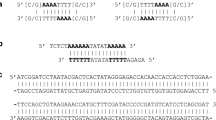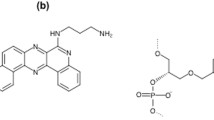Abstract
DNA curvature is the result of a combination of both intrinsic features of the double helix and external distortions introduced by the environment and the binding of proteins or drugs. The propensity of certain double-stranded DNA (dsDNA) sequences to bend is essential in crucial biological processes, such as replication and transcription, in which proteins are known to either recognize noncanonical DNA conformations or promote their formation upon DNA binding. Trabectedin (Yondelis®) is a clinically used antitumor drug which, following covalent bond formation with the 2-amino group of guanine, induces DNA curvature and enhances the circularization ratio, upon DNA ligation, of several dsDNA constructs but not others. By means of unrestrained molecular dynamics simulations using explicitly solvated all-atom models, we rationalize these experimental findings in structural terms and shed light on the crucial, albeit possibly underappreciated, role played by T4 DNA ligase in stabilizing a bent DNA conformation prior to cyclization. Taken together, our results expand our current understanding on how DNA shape modification by trabectedin may affect both the sequence-specific recognition by transcription factors to promoter sites and RNA polymerase II binding.






Similar content being viewed by others
References
Rinehart KL, Holt TG, Fregeau NL, Stroh JG, Keifer PA, Sun F, Li LH, Martin DG (1990) Ecteinascidins 729, 743, 745, 759A, 759B, and 770: potent antitumor agents from the Caribbean tunicate Ecteinascidia turbinata. J Org Chem 55(15):4512–4515. https://doi.org/10.1021/jo00302a007
Cuevas C, Pérez M, Martín MJ, Chicharro JL, Fernández-Rivas C, Flores M, Francesch A, Gallego P, Zarzuelo M, de la Calle F, García J, Polanco C, Rodríguez I, Manzanares I (2000) Synthesis of ecteinascidin ET-743 and phthalascidin Pt-650 from cyanosafracin B. Org Lett 2(16):2545–2548. https://doi.org/10.1021/ol0062502
Larsen AK, Galmarini CM, D’Incalci M (2016) Unique features of trabectedin mechanism of action. Cancer Chemother Pharmacol 77(4):663–671. https://doi.org/10.1007/s00280-015-2918-1
Feuerhahn S, Giraudon C, Martínez-Diez M, Bueren-Calabuig JA, Galmarini CM, Gago F, Egly JM (2011) XPF-dependent DNA breaks and RNA polymerase II arrest induced by antitumor DNA interstrand crosslinking-mimetic alkaloids. Chem Biol 18(8):988–999. https://doi.org/10.1016/j.chembiol.2011.06.007
Aune GJ, Takagi K, Sordet O, Guirouilh-Barbat J, Antony S, Bohr VA, Pommier Y (2008) Von Hippel-Lindau-coupled and transcription-coupled nucleotide excision repair-dependent degradation of RNA polymerase II in response to trabectedin. Clin Cancer Res 14(20):6449–6455. https://doi.org/10.1158/1078-0432.CCR-08-0730
Grosso F, Jones RL, Demetri GD, Judson IR, Blay JY, Le Cesne A, Sanfilippo R, Casieri P, Collini P, Dileo P, Spreafico C, Stacchiotti S, Tamborini E, Tercero JC, Jimeno J, D’Incalci M, Gronchi A, Fletcher JA, Pilotti S, Casali PG (2007) Efficacy of trabectedin (ecteinascidin-743) in advanced pretreated myxoid liposarcomas: a retrospective study. Lancet Oncol 8(7):595–602. https://doi.org/10.1016/S1470-2045(07)70175-4
Forni C, Minuzzo M, Virdis E, Tamborini E, Simone M, Tavecchio M, Erba E, Grosso F, Gronchi A, Aman P, Casali P, D’Incalci M, Pilotti S, Mantovani R (2009) Trabectedin (ET-743) promotes differentiation in myxoid liposarcoma tumors. Mol Cancer Ther 8(2):449–457. https://doi.org/10.1158/1535-7163.MCT-08-0848
Di Giandomenico S, Frapolli R, Bello E, Uboldi S, Licandro SA, Marchini S, Beltrame L, Brich S, Mauro V, Tamborini E, Pilotti S, Casali PG, Grosso F, Sanfilippo R, Gronchi A, Mantovani R, Gatta R, Galmarini CM, Sousa-Faro JM, D’Incalci M (2014) Mode of action of trabectedin in myxoid liposarcomas. Oncogene 33(44):5201–5210. https://doi.org/10.1038/onc.2013.462
García-Nieto R, Manzanares I, Cuevas C, Gago F (2000) Bending of DNA upon binding of ecteinascidin 743 and phthalascidin 650 studied by unrestrained molecular dynamics simulations. J Am Chem Soc 122(30):7172–7182. https://doi.org/10.1021/ja000964q
Zewail-Foote M, Hurley LH (1999) Ecteinascidin 743: a minor groove alkylator that bends DNA toward the major groove. J Med Chem 42(14):2493–2497. https://doi.org/10.1021/jm990241l
Lee MD, Ellestad GA, Borders DB (2002) Calicheamicins: discovery, structure, chemistry, and interaction with DNA. Acc Chem Res 24(8):235–243. https://doi.org/10.1021/ar00008a003
Salzberg AA, Dedon PC (2000) DNA bending is a determinant of calicheamicin target recognition. Biochemistry 39(25):7605–7612. https://doi.org/10.1021/bi992227g
Shore D, Langowski J, Baldwin RL (1981) DNA flexibility studied by covalent closure of short fragments into circles. Proc Natl Acad Sci USA 78(8):4833–4837
Williamson A, Leiros HS (2020) Structural insight into DNA joining: from conserved mechanisms to diverse scaffolds. Nucleic Acids Res 48(15):8225–8242. https://doi.org/10.1093/nar/gkaa307
Shi K, Bohl TE, Park J, Zasada A, Malik S, Banerjee S, Tran V, Li N, Yin Z, Kurniawan F, Orellana K, Aihara H (2018) T4 DNA ligase structure reveals a prototypical ATP-dependent ligase with a unique mode of sliding clamp interaction. Nucleic Acids Res 46(19):10474–10488. https://doi.org/10.1093/nar/gky776
Macke T, Case DA (1998) Modeling unusual nucleic acid structures. In: Leontes NB, SantaLucia J (eds) Molecular modeling of nucleic acids. American Chemical Society, Washington, pp 379–393
Case DA, Ben-Shalom IY, Brozell SR, Cerutti DS, Cheatham TE III, Cruzeiro VWD, Darden TA, Duke RE, Ghoreishi D, Gilson MK, Gohlke H, Goetz AW, Greene D, Harris R, Homeyer N, Huang Y, Izadi S, Kovalenko A, Kurtzman T, Lee TS, LeGrand S, Li P, Lin C, Liu J, Luchko T, Luo R, Mermelstein DJ, Merz KM, Miao Y, Monard G, Nguyen C, Nguyen H, Omelyan I, Onufriev A, Pan F, Qi R, Roe DR, Roitberg A, Sagui C, Schott-Verdugo S, Shen J, Simmerling CL, Smith J, SalomonFerrer R, Swails J, Walker RC, Wang J, Wei H, Wolf RM, Wu X, Xiao L, York DM, Kollman PA (2018) AMBER 2018. University of California, San Francisco
Harris SA, Laughton CA, Liverpool TB (2008) Mapping the phase diagram of the writhe of DNA nanocircles using atomistic molecular dynamics simulations. Nucleic Acids Res 36(1):21–29. https://doi.org/10.1093/nar/gkm891
Mills A, Gago F (2020) Atomistic insight into sequence-directed DNA bending and minicircle formation propensity in the absence and presence of phased A-tracts. J Comput Aided Mol Des 34(3):253–265. https://doi.org/10.1007/s10822-020-00288-z
Li P, Merz KM Jr (2014) Taking into account the ion-induced dipole interaction in the nonbonded model of ions. J Chem Theory Comput 10(1):289–297. https://doi.org/10.1021/ct400751u
Wang H, Laughton CA (2010) Molecular modelling methods to quantitate drug-DNA interactions. Methods Mol Biol 613:119–131. https://doi.org/10.1007/978-1-60327-418-0_8
Sainz-Díaz CI, Manzanares I, Francesch A, García-Ruiz J (2003) The potent anticancer compound ecteinascidin-743 (ET-743) as its 2-propanol disolvate. Acta Crystallogr C 59(Pt 4):O197-198. https://doi.org/10.1107/s0108270103003676
Bueren-Calabuig JA, Giraudon C, Galmarini CM, Egly JM, Gago F (2011) Temperature-induced melting of double-stranded DNA in the absence and presence of covalently bonded antitumour drugs: insight from molecular dynamics simulations. Nucleic Acids Res 39(18):8248–8257. https://doi.org/10.1093/nar/gkr512
Marco E, Negri A, Luque FJ, Gago F (2005) Role of stacking interactions in the binding sequence preferences of DNA bis-intercalators: insight from thermodynamic integration free energy simulations. Nucleic Acids Res 33(19):6214–6224. https://doi.org/10.1093/nar/gki916
Gallego J, Luque FJ, Orozco M, Burgos C, Alvarez-Builla J, Rodrigo MM, Gago F (1994) DNA sequence-specific reading by echinomycin: role of hydrogen bonding and stacking interactions. J Med Chem 37(11):1602–1609. https://doi.org/10.1021/jm00037a010
Ivani I, Dans PD, Noy A, Perez A, Faustino I, Hospital A, Walther J, Andrio P, Goni R, Balaceanu A, Portella G, Battistini F, Gelpi JL, Gonzalez C, Vendruscolo M, Laughton CA, Harris SA, Case DA, Orozco M (2016) Parmbsc1: a refined force field for DNA simulations. Nat Methods 13(1):55–58. https://doi.org/10.1038/nmeth.3658
Waterhouse A, Bertoni M, Bienert S, Studer G, Tauriello G, Gumienny R, Heer FT, de Beer TAP, Rempfer C, Bordoli L, Lepore R, Schwede T (2018) SWISS-MODEL: homology modelling of protein structures and complexes. Nucleic Acids Res 46(W1):W296–W303. https://doi.org/10.1093/nar/gky427
Maier JA, Martinez C, Kasavajhala K, Wickstrom L, Hauser KE, Simmerling C (2015) ff14SB: Improving the accuracy of protein side chain and backbone parameters from ff99SB. J Chem Theory Comput 11(8):3696–3713. https://doi.org/10.1021/acs.jctc.5b00255
Lavery R, Moakher M, Maddocks JH, Petkeviciute D, Zakrzewska K (2009) Conformational analysis of nucleic acids revisited: Curves+. Nucleic Acids Res 37(17):5917–5929. https://doi.org/10.1093/nar/gkp608
Roe DR, Cheatham TE 3rd (2013) PTRAJ and CPPTRAJ: software for processing and analysis of molecular dynamics trajectory data. J Chem Theory Comput 9(7):3084–3095. https://doi.org/10.1021/ct400341p
Sild M, Chatelain RP, Ruthazer ES (2013) Improved method for the quantification of motility in glia and other morphologically complex cells. Neural Plast 2013:853727. https://doi.org/10.1155/2013/853727
Li J, Sagendorf JM, Chiu TP, Pasi M, Pérez A, Rohs R (2017) Expanding the repertoire of DNA shape features for genome-scale studies of transcription factor binding. Nucleic Acids Res 45(22):12877–12887. https://doi.org/10.1093/nar/gkx1145
Rube HT, Rastogi C, Kribelbauer JF, Bussemaker HJ (2018) A unified approach for quantifying and interpreting DNA shape readout by transcription factors. Mol Syst Biol 14(2):e7902. https://doi.org/10.15252/msb.20177902
Battistini F, Hospital A, Buitrago D, Gallego D, Dans PD, Gelpi JL, Orozco M (2019) How B-DNA dynamics decipher sequence-selective protein recognition. J Mol Biol 431(19):3845–3859. https://doi.org/10.1016/j.jmb.2019.07.021
Dziubanska-Kusibab PJ, Berger H, Battistini F, Bouwman BAM, Iftekhar A, Katainen R, Cajuso T, Crosetto N, Orozco M, Aaltonen LA, Meyer TF (2020) Colibactin DNA-damage signature indicates mutational impact in colorectal cancer. Nat Med 26(7):1063–1069. https://doi.org/10.1038/s41591-020-0908-2
Chakraborty A, Lyonnais S, Battistini F, Hospital A, Medici G, Prohens R, Orozco M, Vilardell J, Sola M (2017) DNA structure directs positioning of the mitochondrial genome packaging protein Abf2p. Nucleic Acids Res 45(2):951–967. https://doi.org/10.1093/nar/gkw1147
Gietl A, Grohmann D (2013) Modern biophysical approaches probe transcription-factor-induced DNA bending and looping. Biochem Soc Trans 41(1):368–373. https://doi.org/10.1042/BST20120301
Ogata K, Sato K, Tahirov TH (2003) Eukaryotic transcriptional regulatory complexes: cooperativity from near and afar. Curr Opin Struct Biol 13(1):40–48
Su W, Jackson S, Tjian R, Echols H (1991) DNA looping between sites for transcriptional activation: self-association of DNA-bound Sp1. Genes Dev 5(5):820–826
Lara-González S, Dantas Machado AC, Rao S, Napoli AA, Birktoft J, Di Felice R, Rohs R, Lawson CL (2020) The RNA polymerase a subunit recognizes the DNA shape of the upstream promoter element. Biochemistry 59(48):4523–4532. https://doi.org/10.1021/acs.biochem.0c00571
Haran TE, Mohanty U (2009) The unique structure of A-tracts and intrinsic DNA bending. Q Rev Biophys 42(1):41–81. https://doi.org/10.1017/S0033583509004752
Zhou T, Yang L, Lu Y, Dror I, Dantas Machado AC, Ghane T, Di Felice R, Rohs R (2013) DNAshape: a method for the high-throughput prediction of DNA structural features on a genomic scale. Nucleic Acids Res 41((Web Server issue)):W56-62. https://doi.org/10.1093/nar/gkt437
Abe N, Dror I, Yang L, Slattery M, Zhou T, Bussemaker HJ, Rohs R, Mann RS (2015) Deconvolving the recognition of DNA shape from sequence. Cell 161(2):307–318. https://doi.org/10.1016/j.cell.2015.02.008
Basu A, Bobrovnikov DG, Qureshi Z, Kayikcioglu T, Ngo TTM, Ranjan A, Eustermann S, Cieza B, Morgan MT, Hejna M, Rube HT, Hopfner KP, Wolberger C, Song JS, Ha T (2021) Measuring DNA mechanics on the genome scale. Nature 589(7842):462–467. https://doi.org/10.1038/s41586-020-03052-3
Acknowledgements
A.M. gratefully acknowledges being the recipient of a predoctoral fellowship from the University of Alcalá. This work has been financially supported by the Spanish MICINN [Project PID2019-104070RB-C22] and PharmaMar S.A.U. (Colmenar Viejo, Madrid, Spain).
Funding
Financial support from the Spanish Ministerio de Economía y Competitividad (SAF2015-64629-C2-2-R) and PharmaMar S.A.U. is gratefully acknowledged.
Author information
Authors and Affiliations
Corresponding author
Ethics declarations
Conflicts of interest
There are no conflicts to declare.
Additional information
This work is dedicated to Professor Emeritus Laurence Hurley (The University of Texas at Austin) in recognition of his mentorship and inspiring scientific contributions in the field of DNA binding drugs.
Publisher's Note
Springer Nature remains neutral with regard to jurisdictional claims in published maps and institutional affiliations.
Supplementary Information
Below is the link to the electronic supplementary material.
Rights and permissions
About this article
Cite this article
Mills, A., Gago, F. Insight into the sequence-specific elements leading to increased DNA bending and ligase-mediated circularization propensity by antitumor trabectedin. J Comput Aided Mol Des 35, 707–719 (2021). https://doi.org/10.1007/s10822-021-00396-4
Received:
Accepted:
Published:
Issue Date:
DOI: https://doi.org/10.1007/s10822-021-00396-4




